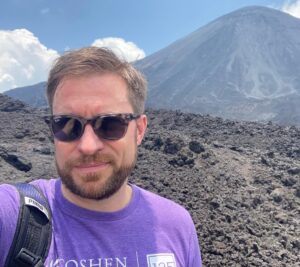by Robert Brenneman, originally published in Menno Snapshots by Mennonite Church USA
This post is part of the MennoCon23 #BeTransformed series. MennoCon23 will be held in Kansas City, Missouri, July 3-6.

Robert Brenneman is the director of criminal justice and restorative justice and professor of sociology at Goshen College. A graduate of Eastern Mennonite University and former service-worker with Mennonite Central Committee, Rob is the author of “Homies and Hermanos: God and Gangs in Central America” and teaches courses in sociology, criminal justice, and peace, justice, and conflict studies. At MennoCon23 he will deliver separate seminars called “Gang Violence and the Global Church” and “Help! My phone is stuck to my face!”
______________________________
The first time I met JJ it was at his place of work, a computer parts wholesaler in Guatemala City, Guatemala. Having made contact through a mutual friend, I arrived that day with the goal of interviewing JJ for a dissertation in sociology.
I was interested in exploring what would make a gang member leave the gang and why so many of those who left were joining a church on the way out.
But first, I wanted to understand the attraction to the gang itself. JJ was kind enough to describe to me his own journey into the gang. It began with the death of his father and the excruciating experience of neglect and abuse at the hands of his mother and brother. When, at the age of 9, JJ was handed a pistol by some older gang members who dared him to rob the corner store, he did exactly that, returning to the older boys with a wad of cash in hand. Afterward, the “errands” got riskier and more challenging. Before long, JJ was an active member of the local chapter of the White Fence gang, a transnational gang with roots in Los Angeles, California. By the time he was 16, JJ was the leader of two White Fence “clicas” or gang cells. When I met him, he was in his mid-20s, had left the gang a few years earlier, and was working a steady job, while trying to keep a low profile and stay out of the path of his former friends and enemies.
JJ’s personal story of joining the gang in the early 2000s shared many themes with the interviews I conducted with 63 former gang members in the late 2000s. Boys, and a few girls, who felt invisible and saw little hope for achieving economic stability or respect by traditional — legal — paths, found a set of “short-cuts” to adulthood and status in the gang. Most of all, the gangs offered recipes for using street violence to transform the shame of being poor and forgotten, into cash, clothing, belonging and a “respectable” identity — respectable among youth peers, anyway. For tens of thousands of Central American youths, it was an offer that was too tempting to pass up. In postwar economies ravaged by unemployment, racism and inequality, the gangs had no trouble growing their ranks. Once the handguns started flowing in from the north, the gangs quickly turned impoverished neighborhoods into war zones, as rival gangs competed for territory to sell drugs and extract extortion fees.
Many of these neighborhoods are home to small, but thriving, Mennonite congregations. After all, Central America is home to tens of thousands of Mennonites in hundreds of churches across the region. One of those churches, Iglesia Roca de Salvación, in Zone 6 of Guatemala City, recently found itself with a difficult decision to make. A notorious gang member who lived across the street from the church had been killed in a gang rivalry. Many in the local neighborhood openly expressed relief or even satisfaction when the young man was killed. After all, hadn’t he been an active member of a group that was responsible for years of death and destruction in countless households in the community? “What goes around comes around,” right? But then came a difficult moment — when the mother of the young man came to Pastor Yanett Palacios and asked if she and her husband would conduct the funeral for her son and host it in the church. This was no easy decision. The young man was not a member of the church — or any church — and Pastor Yanett knew that she would face criticism from neighbors if she “honored” the deceased man in this way.
But she also knew that a follower of Jesus can’t be selective when expressing compassion for families who are hurting, and everyone deserves a decent burial.
After consulting the leadership of the church, she agreed to host the funeral no matter the cost.
Sure enough, the criticisms came, fast and furious. Some even came from inside the congregation itself. “Are these the kind of people we want to be associated with? Won’t this ruin our testimony?” But the church ploughed ahead, conducting the funeral and providing a meal, even though it meant opening its doors to many of the friends and co-conspirators of the deceased. One partial result of that experience was new members in the church, including Gabriela,[1] a former gang member, along with her young children. Gabriela discovered a place where she could find refuge from the ravages of a former life and a helping hand for building a new life in the church. Life outside the gang hasn’t been easy, but the support of a congregation has made it at least possible.
Pastor Yanett and her congregation are not unique among Mennonite congregations in urban Central America. Many have come face to face with the violence not only of gangs but of drug traffickers, corrupt politicians and more. This violence brings difficult moments and difficult decisions. We, in the north, can take inspiration from their courage and hospitality, even as we promote policies at the local and national level that welcome those fleeing the same violence. We can extend the same grace and refuge that our brothers and sisters in Central America, and elsewhere, have shared with those around them for decades.
[1] This name has been changed for privacy.

Register for MennoCon23 today!
The views and opinions expressed in this blog belong to the author and are not intended to represent the views of the MC USA Executive Board or staff.
Interested in submitting a blog for Menno Snapshots? Please see our blog guidelines here.

